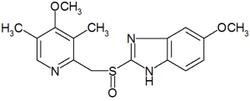Omeprazole
Omeprazole (INN) (IPA: ) is a proton pump inhibitor used in the treatment of dyspepsia, peptic ulcer disease (PUD), GORD and Zollinger-Ellison syndrome. It is marketed by AstraZeneca under the tradenames Losec and Prilosec, commonly as the magnesium salt omeprazole magnesium. Omeprazole is one of the most widely prescribed drugs internationally and is available over the counter in some countries. more...
Faced with the loss of patent protection and competition from generic manufacturers, AstraZeneca developed, launched, and heavily marketed esomeprazole (Nexium), a single enantiomer form of omeprazole.
In 1990, in the U.S., at the FDA's request, the brand name Losec was changed to Prilosec to avoid confusion with the diuretic Lasix (furosemide).
Clinical use
Use in Helicobacter pylori eradication
Omeprazole is combined with the antibiotics clarithromycin and amoxicillin (or metronidazole in penicillin-hypersensitive patients) in the one week eradication triple therapy for Helicobacter pylori. Infection by H. pylori is the causative factor in the majority of peptic and duodenal ulcers.
Dosage forms
Omeprazole is available as tablets and capsules (containing omeprazole or omeprazole magnesium) in strengths of 10 mg, 20 mg, and in some markets 40 mg; and as a powder (omeprazole sodium) for intravenous injection. Oral omeprazole preparations are always enteric-coated, due to the rapid degradation of the drug in the acidic conditions of the stomach. This is most commonly achieved by formulating enteric-coated granules within capsules, enteric-coated tablets, and the multiple-unit pellet system.
Multiple unit pellet system
Omeprazole tablets manufactured by AstraZeneca (notably Losec/Prilosec) are formulated as a "multiple unit pellet system" (MUPS). Essentially, the tablet consists of extremely small enteric-coated granules (pellets) of the omeprazole formulation inside an outer shell. When the tablet is immersed in an aqueous solution, as happens when the tablet reaches the stomach, water enters the tablet by osmosis. The contents swell from water absorption causing the shell to burst, releasing the enteric-coated granules. For most patients, the multiple-unit pellet system is of no advantage over conventional enteric-coated preparations. Patients for which the formulation is of benefit include those requiring nasogastric tube feeding and those with difficulty swallowing (dysphagia).
The granules are manufactured in a fluid bed system with with small sugar spheres as the starting material. The sugar spheres are sequentially spray-coated with a suspension containing omeprazole, a protective layer to prevent degradation of the drug in manufacturing, an enteric coating and an outer layer to reduce granule aggregation. The granules are mixed with other inactive excipients and compressed into tablets. Finally, the tablets are film-coated to improve the stability and appearance of the preparation.
Read more at Wikipedia.org


